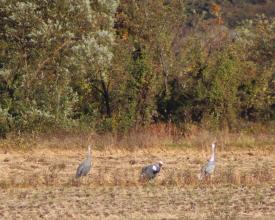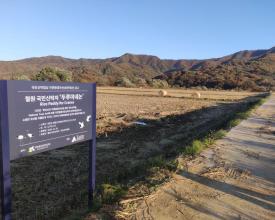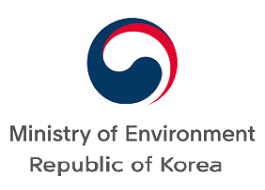
Cranes over Cheorwon, cultivating conservation and community: results from the Nature Coexistence between farmers and cranes
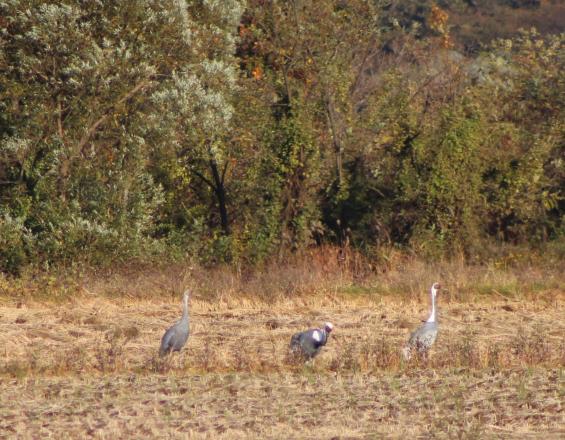
The conservation efforts in Cheorwon, Gangwon-do, are a collaborative initiative by local farmers and various organizations, including the National Nature Trust, Cheorwon Crane Protection Association, and others, to preserve endangered crane habitats. These efforts have led to a notable increase in crane populations, thanks to sustainable agricultural practices, ecotourism, and community-driven conservation activities. The National Nature Trust plays a pivotal role, supported by legal frameworks and financial mechanisms, in managing conservation assets like 'the Cheorwon Crane Land.' This multifaceted approach integrates ecological preservation with local economic development, showcasing a successful model of conservation that promotes the coexistence of human and wildlife interests.
Context
Challenges addressed
Following the partial withdrawal of some areas from the Civilian Control Zone (CCZ) in 2012, there has been an increase in greenhouse construction. This development poses a threat to the habitat of cranes by potentially reducing the available land for rice paddies and natural habitats essential for their survival.
Despite the success in increasing crane populations through sustainable agriculture and conservation efforts, there's an emerging concern over maintaining these successes. The challenge lies in ensuring ongoing community engagement and implementing conservation initiatives that actively involve residents to counteract any negative impacts of development and habitat loss.
Location
Process
Summary of the process
The solution to address the challenges facing the cranes in Cheorwon involves a multi-tiered approach that integrates the efforts of local communities, conservation organizations, and corporate sponsors. This integrated conservation efforts model is to sustain the agricultural environment that cranes depend on while fostering economic growth for the local community and promoting ecotourism.
These efforts promote local agricultural practices to global conservation campaigns, highlighting the connections between local actions (e.g., habitat maintenance), community engagement (e.g., ecotourism), collaborative governance (e.g., agreements between organizations), and support mechanisms (e.g., legal framework, corporate sponsorship). Each element is interconnected, showing how grassroots efforts are amplified by organizational and corporate support to achieve the shared goal of crane conservation and community development.
Building Blocks
Cheorwon Rice Paddy, the largest wintering site for cranes
Cheorwon, situated in the vicinity of the Demilitarized Zone (DMZ), stands as a crucial wintering ground for cranes, an endangered species. Due to restricted development and civilian access since the Armistice Agreement in 1953, the area has become vital for the survival of these birds. The Cheorwon Plain, with its expansive farmlands and reservoirs, along with the wetlands of the DMZ, serves as essential feeding and resting grounds for crane species.
A positive trend has been observed in crane populations, with 372 red-crowned cranes and 474 white-napped cranes in the Cheorwon Plain in January 1999 (Kim Sang-won, et al. 2020). This upward trajectory has continued, reaching 833 red-crowned cranes and 2,766 white-napped cranes in January 2017. The commitment of local farmers, particularly since 2004, in preserving rice straws and providing water to rice paddies under the Biodiversity Management Agreement Project has played a significant role in this success.
This trust initiative aligns with the Global Trust's mission to safeguard private land in the DMZ (South) and the Civilian Control Zone, preserving it as public property and a 'common heritage of mankind' in the face of development pressures.
Enabling factors
- Integrated partnerships: Collaboration among local farmers, local communities, groups, government, and private sector
- Legal support: The National Trust Act and related policies provide a legal basis for habitat management and conservation funding
- Community engagement and involvement: Engaging locals through economic incentives like ecotourism and sustainable farming practices
- Private sector engagement: private sector support and public campaigns
- Adaptive management: research and habitat monitoring inform conservation strategies,
Lesson learned
The Cheorwon case study offers several valuable lessons for conservation and sustainable community-based conservation:
- Collaborative efforts enhance conservation: the synergy between local communities, conservation organizations, and corporate sponsors maximizes the effectiveness of conservation efforts.
- Economic incentives promote conservation: integrating conservation with economic benefits, such as ecotourism and product branding, motivates community participation and support.
- Legal frameworks support initiatives: a strong legal foundation, like the National Trust Act, is crucial for facilitating and securing conservation efforts and funding.
- Adaptive management ensures sustainability: continuous monitoring and adapting conservation strategies based on ecological and social feedback ensure long-term sustainability.
- Broad stakeholder engagement is key: involving a wide range of stakeholders, from local communities to international corporations, creates a comprehensive support network for conservation efforts.
Maintenance of agricultural environment and conservation of cranes
Local communities are actively contributing to habitat conservation through initiatives like preserving rice straws and providing water to rice paddies in winter, facilitated by Payment of Ecosystem Service (PES) contracts. Engaging in 'ecotourism programs, including crane birdwatching activities, and hosting 'Crane Seminars,' they create added value for their efforts. Furthermore, farmers in the Cheorwon area have taken an innovative approach by producing 'Cheorwon Odae Rice' and promoting their product brand using the image of the crane.
'The Cheorwon Crane Land,' serving as a conservation asset under the stewardship of the National Nature Trust is situated in Yangji-ri, which boasts a fertile plain and is adjacent to Togyo Reservoir and the Hantangang River, resulting in abundant water resources. This geographical advantage makes it a haven for various migratory birds that flock to the area every winter, typically from mid-October to March. Embracing its rich ecological setting, Yangji-ri has actively pursued becoming a full-fledged eco-village. This commitment has earned notable recognitions, including being selected as an eco-friendly excellent village in 2000, becoming a project operator of the New Rural Construction.
Enabling factors
- Habitat conservation: Preserving the agricultural environment in a way that supports wildlife, especially migratory birds like cranes
- Community engagement: Encouraging local residents to participate actively in conservation efforts requires overcoming inertia
- Sustainable ecotourism development: Developing ecotourism, such as birdwatching activities and educational seminars
- Economic sustainability: Finding viable economic models, such as the PES contracts, that incentivize conservation while also supporting the local economy is a complex task.
Lesson learned
The efforts in Cheorwon illustrate the importance of integrating conservation activities with local economic development. By aligning the interests of wildlife conservation with those of local farmers and the wider community, a more sustainable and mutually beneficial outcome is achieved.
Initiatives like preserving rice straws and providing water to paddies, supported by PES contracts, demonstrate how community involvement can lead to significant ecological benefits.
The geographical advantages of Yangji-ri, with its fertile plains and abundant water resources, underscore the potential of leveraging local natural resources for conservation purposes. These resources provide a foundation for the area's success in attracting migratory birds and supporting biodiversity.
The series of awards received by Yangji-ri serve as powerful motivators for continued ecological and conservation efforts. These accolades not only provide validation for the work done but also inspire further commitment to environmental stewardship and sustainable development.
Crane-based eco-tourism
The five villages frequented by cranes, the Cheorwon Crane Protection Association, the Bird Protection Association, the Crane Photography Club, the Farmers' Association, and other local residents and organizations deeply loving cranes formed and operate the ‘Cheorwon DMZ Crane Ecotourism Council’, extending beyond individual efforts. Under the leadership of local communities, it focused on sustaining the crane habitat. These include initiatives such as watering rice paddies, providing cranes with snails as a food source, and preserving rice straws on the fields. Notably, the council advocates for a form of tourism aligned with nature conservation.
Despite potential inconveniences, the emphasis is on a crane birdwatching program that adheres to birdwatching etiquette: 1) loving nature, 2) refraining from entering restricted areas, 3) avoiding collection or damage to natural elements, 4) maintaining cleanliness of facilities, 5) embracing slow travel, and 6) choosing local accommodations.
In conjunction with the arrival of migratory birds, the local residents actively engage in crane population surveys and feeding activities in collaboration with esteemed experts from organizations such as the National Nature Trust and the Crane Protection Association
Enabling factors
- Ensuring the sustainability of crane habitats requires continuous effort and resources. Activities like watering rice paddies and providing food sources need to be carefully managed
- Developing a form of tourism that does not harm the environment while still providing an engaging experience for visitors is challenging
- Coordinating efforts among a diverse group of stakeholders, including local residents, various associations, and conservation experts, can be complex
Lesson learned
The formation and success of the Cheorwon DMZ Crane Ecotourism Council demonstrate the power of community-led conservation efforts. By bringing together various stakeholders with a shared love for cranes, the council has managed to implement meaningful conservation strategies.
The council's emphasis on a birdwatching program that respects nature and promotes environmental protection highlights the importance of sustainable ecotourism
The collaboration between local communities and experts from organizations like the National Nature Trust and the Crane Protection Association shows that pooling knowledge and resources can significantly enhance the impact of conservation efforts.
The council's initiatives serve as an educational platform for both locals and visitors, promoting awareness about the importance of conservation and the specific needs of cranes. By advocating for birdwatching etiquette and engaging in community-based conservation activities, the council fosters a culture of respect for nature and wildlife.
The National Nature Trust (NNT) and conservation assets
The acquisition and management of conservation assets, exemplified by entities like 'the Cheorwon Crane Land,' follow a structured legal framework outlined in the 'National Trust Act on Cultural Heritage and Natural Environment Assets'. According to this law, the National Nature Trust (NNT) Board of Directors (BOD) has the authority to make decisions regarding the purchase of such conservation assets (Article 12).
The National Nature Trust employs a multifaceted approach to effectively conserve and manage 'the Cheorwon Crane Land.' To this end, the National Nature Trust issues ‘Crane Eco Securities' signs MOU with ‘the Cheorwon Branch of Korea Crane Protection Association’ (December 2016), and conducts the annual events such as crane population surveys, birdwatching, and bird feeding activities in the DMZ area (held from December to February).
The commitment to conservation extends beyond local efforts, as demonstrated by the 'DMZ Global Trust Campaign.' This initiative aims to broaden and sustainably utilize crane habitats, leveraging the ESG practices of companies both domestically and internationally. The overarching goal is to advocate for the continuous promotion of the 'DMZ Eco Belt’. One strategic plan within this campaign involves expanding OECM (Other Effective Area-Based Conservation Measures).
Enabling factors
- Sustainable finance: Necessary for securing the funds for conservation activities, engaging the private sector, and broadening the support base.
- Legal framework: Essential for setting guidelines for acquisition, management, and support of conservation efforts.
- Government support: Crucial for funding and policy backing, ensuring financial and regulatory support for conservation initiatives.
Lesson learned
Natural Benefit Eco Securities (from free-riding to payment): This involves pricing the benefits of nature on the securities, and individuals or entities purchasing these securities become members of the National Nature Trust. The generated sales revenue, managed by the National Nature Trust, is then utilized to secure public lands and support conservation efforts. Additionally, tax benefits are provided under the Income Tax Act and Corporate Tax Act to incentivize participation.
The establishment of a legal framework specific to the conservation of natural and cultural heritage assets is crucial. It provides a structured approach to acquisition, management, and support for conservation efforts, thereby ensuring that activities are both effective and compliant with national laws.
Impacts
These nature conservation efforts have positively impacted biodiversity by protecting the cranes and maintaining the ecosystem, ensuring sustainable land management, and contributing to the region's ecological health and resilience. It has also led to the local community empowerment and livelihood, fostering a sense of ownership and responsibility towards environmental conservation.
Beneficiaries
Local communities in Cheorwon and local farmers benefit through economic development opportunities, such as ecotourism and the marketing of "Cheorwon Odae Rice," entities like the National Nature Trust, the Cheorwon Crane Protection Association.
Sustainable Development Goals
Story
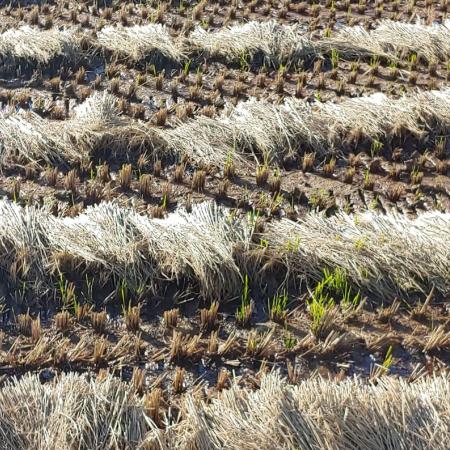
In Cheorwon, a traditional rice paddy is critical to accommodate migratory cranes and provide food for cranes during their transit, particularly in winter. It conserves nature effectively but is not a formal protected area. Rather it has been conserved by Cheorwon Crane Protection Association commissioned by the National Nature Trust, notably by Cheorwon local Mr Baek Jong-han, who works tirelessly to protect cranes. Mr Baek has been observing these cranes for more than 30 years.
“I have observed these cranes daily, and it is a delight to see their numbers stabilise and increase. They are regular visitors; this is their haven".
The National Nature Trust purchased this site through the financial support of Lam Research Korea and managed it as trust assets. And Korea National Parks Service(KNPS) is supposed to provide conservation technical advice and guidance, as an institution specializing in the management of protected areas. “For KNPS, we are so pleased to support such dedicated local actors to help them achieve effective conservation of the crane and share in the success for their own values and benefits”, Dr Heo Hag Young mentioned.
The rice paddy for cranes is clearly demonstrating effective conservation for important local and national species values, also globally listed by IUCN. The site is now a candidate site that can be considered as an “other effective area-based conservation measure” or OECM.
The rice paddy is and has been governed and managed in a way that secures these natural values whilst also recognising and assuring other locally relevant values in and around the site, such as farming, eco-tourism and ecosystem services that support local farmers and residents. The local communities see great value in conserving the habitats for the cranes and have created innovative conservation contracts to achieve these outcomes. The area falls under the National Trust Act, which allows for a clear legal basis for the long-term effectiveness and monitoring of the site.
The site will also advance through the IUCN Green List programme, making it one of the world’s first Green Listed OECMs. The IUCN Green List Standard, which describes the elements of effective and equitable protected and conserved areas globally will further recognise and support the rice paddy for cranes.
